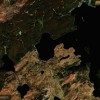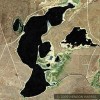
Zhang Heng’s “Bird’s Eye” Map?
Posted on Thursday, April 8th, 2010
I believe this “Bird’s Eye” map may be the prototype of the ancient Chinese quantitative rectangular grid mapping system.
Most maps are scaled down reproductions of a specific area and by definition “bird’s eye views”. Why then would Zhang Heng (78-139 AD) call his map among the most famous missing maps in history, “The Bird’s Eye” map?
Zhang Heng was one of the brightest minds in history. Among his accomplishments are the first seismograph, advances in time keeping, the first odometer and being the genius behind the Chinese grid mapping system as well as other inventions and studies. In addition to being among the top scientists of his day he was also a poet beautifully joining art and science. An individual feat rarely accomplished.
It is my belief that Zhang Heng‚Äôs ‚ÄúBird‚Äôs Eye Map‚Äù in original form could never be found in any museum or any other building for that matter because no building¬Ý would ever be big enough to contain it. His ‚ÄúBird‚Äôs Eye‚Äù Map is exactly what he called it. It‚Äôs a ‚ÄúBird‚Äôs Eye‚Äù view literally. What better way to prove that a new mapping system would work than to grid it out on a huge area of land using a land measuring device he had invented in conjunction with the grid mapping system that he also had invented.
If the map grid is accurate at zero percent reduction it could then be reproduced at a reduced scale accurately. The “Bird’s Eye” Map Can Only Be Seen From A Bird’s Eye i.e. great altitude. This mapping system has been historically acknowledged and globally accepted. For unknown reasons this incredible process was later apparently lost. The grid mapping process discovered by Zhang Heng was far more accurate than other mapping systems known to the world for many centuries after its creation.
Where then is Zhang Heng’s “Bird’s Eye Map”? It’s located in North America. It’s centered at Swan Hills, Alberta, Canada but the grids extend throughout many areas of Alberta, Canada and extend to locations in Texas and New Mexico. Radiating from Odessa Texas these grids are best seen from 2 miles per inch on the Google map legend.
SCIENTIFIC CARTOGRAPHY
THE CONTINUOUS CHINESE GRID TRADITION
- The essential point which is now to be made is that just as the scientific cartography of the Greeks was disappearing from the European scene, the same science in different form began to be cultivated among the Chinese. A tradition which continued without interruption down to the coming of the Jesuits was born in the work of Chang Heng (+78 to + 139), the contemporary, as has been said, of that Marinus of Tyre who was one of Ptolemy’s principal sources.
- None of the fragments of Chang Heng’s writings which survive deals with cartography, but that it was he who originated the rectangular grid system seems very probable from the pregnant phrase used about him by Tshai Yung. He is said to have ‘cast a network (of coordinates) about heaven and earth, and reckoned on the basis of it’
- ‘If one draws a map without having graduated divisions, there is no means of distinguishing between what is near and what is far.‘But if we examine a map which has been prepared by the combination of all these principles, we find that a true scale representation of the distances is fixed by the graduated divisions.
- Although Phei Hsiu (Phi Xiu) (+224 to +271) left us so clear an account of his methods, his actual maps did not survive in any form, though modern scholars have made attempts at reconstructing them.Moreover, the ancient methods of divination in which ‘pieces ‘ like chess-men(chhi) were thrown on to a marked board, perhaps the shih itself, seem to have been connected with another old system of coordinates.But the exact connections between the coordinate system of chess (or rather ‘pre-chess’, if the term be allowable) and that of cartographic practice require much further investigation.
- The proper place for the main discussion of the hodometer (called chi li ku chhe, ‘mile-counting drum carriage’) will be in Section 27c on engineering, but in view of the fact that Chinese map-making must have involved so much dead-reckoning, one cannot help wondering whether such men as Chang Heng, Phei Hsiu (Phi Xiu) and Chia Tan did not make some use of it.
- The suggestion is therefore permissible that the advances of cartography in +14th and +15th-century Europe¬Ý were due, not only to the study of Ptolemy by the Arabs, but also to some transmission of quantitative cartographic principles from China
Science and Civilization in China, Volume III Joseph Needham
- Page 533
- Page 537-538
- Page 540
- Page 540 & 542
- Page 579
- Page 589
The Genius of China
- Chang Heng invented quantitative cartography in the second century A.D. This was quantitative cartography of a kind more suitable to a computer since it entirely dispensed with images. (Page 30)
- Six (Mapping) Principles Observable
- The graduated divisions
- The rectangular grid
- Pacing out the sides of right angles triangles
- Measuring the high and the low
- Measuring right angles and acute angles
- Measuring curves and straight lines.
‚ÄúWhen the principle of the rectangular grid is properly applied then the straight and the curved, the near and the far, can conceal nothing of their form from us‚Äù.¬Ý (Page 31)
What was happening in Europe while all this was going on? After the time of Ptolemy (c 120-170 AD) Western map making degenerated under the influence of religion to a point scarcely credible……. It was only during the Renaissance that respectable maps once more began to be found in Europe…. but reasonable maps of larger areas did not appear in Europe until the fifteenth century Рthirteen hundred years after Chang Heng introduced scientific quantified cartography to China. (Page 34)
Robert Temple
The Genius of China
It may simply be a coincidence that the Swan Hills Alberta Canada and Odessa/Midland Texas grids have something else in common. They are both located above fairly substantial oil deposits. If this is more than a coincidence then why did the Chinese need oil in the 2nd century AD?
| Those who won this territory were strong; Those who depended on it endured. When a stream is long, its water is not easily exhausted. When roots are deep, they do not rot easily. Therefore, as extravagance and ostentation were given free rein, The odour became pungent and increasingly fulsome. |
|
| Zhang Heng | |
Please remember the name and talents of Zhang Heng. He doesn’t simply belong to China & Asia. He belongs to the entire world for his accomplishments.
Chessboard Near Swan Hills, Canada
Chessboard Near Lake Burnstick Alberta, Canada
Grids Surrounding Odessa Texas
The Beak of the 10th Sun Raven STILL GLOWS!

















